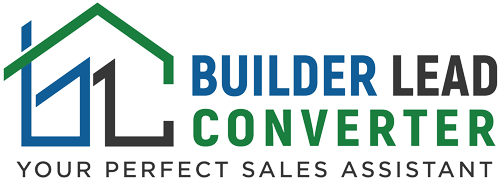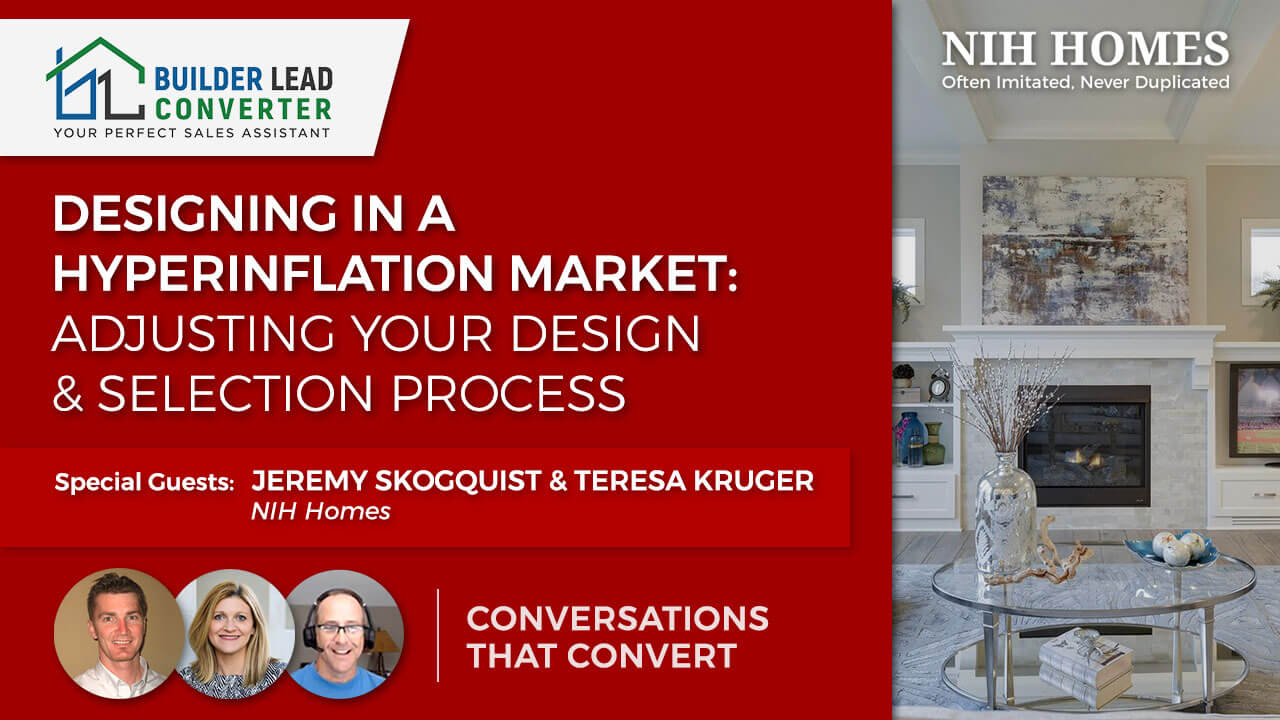With the ever-changing housing market, it’s no wonder that builder’s are having to adjust their design processes.
In this episode of Conversations that Convert we hear from Jeremy Skogquist & Teresa Kruger at NIH Homes about how they have adapted their design and selection process to keep clients happy and most importantly, stay on schedule and budget!
In our hyperinflationary market, it’s more important than ever to make sure you have a streamlined design and selection process. Be sure to watch or listen to the episode below to avoid the mistakes commonly made during the design and selection process.
Builder Lead Lead Converter captures & converts leads for home builders & remodelers so they can grow sales revenue and margins. Find out how https://www.builderleadconverter.com/
To learn more about NIH Homes visit https://www.nihhomes.com/about-us/
Transcript:
Today in Conversations that Convert, we’re gonna be talking about designing in a hyperinflation market. Let’s go ahead and get started.
Welcome to Conversations that Convert every week, we’ll spend about 10 to 15 minutes tackling relevant lead generation marketing and sales topics for remodelers, home improvement companies, and home builders. Conversations that Convert is brought to you by the builder lead converter, your perfect sales assistant.
And now here’s Rick and Daiana.
Rick: Everyone, welcome to conversations that convert Daiana’s off today, but we do have a very special guest for our program. It’s called designing in a hyperinflation market and adjusting your design and selection process. Our special guests today are Jeremy Skogquist and Teresa Kruger from NIH homes, Jeremy and Teresa, welcome to conversations that convert.
Jeremy: Hey.
Rick: Well, it’s lovely to have you all. It, it’s quite a journey Jeremy, that, that, that you have been on with NIH homes. Now, your second generation with you and your brothers, Chad Colt and Teresa. I know you’re a real integral part of the operation as well. So we’re very excited to hear about some of the updates and changes that you’ve made based on the challenges we have with labor shortages and supply changes that have extended our building times. So Teresa, why don’t you just give us a little bit of background, about yourself, you know, who are you, how are you where you are, and what’s been your journey through life to land you here, talking with me on conversations that convert.
Teresa: I’ve kind of been in the design industry for many years. And…
Rick: I know you started in, was it a commercial?
Teresa: Yeah, I did more commercial, design, and High Rise condos. So it was kind of along with commercial lines a little bit more as well. And then some residential as well for many years, I think I’ve been with NIH for eight years. So…
Rick: And designer number three, right? Jeremy, didn’t you have two other designers before Teresa?
Jeremy: Yep. Yep.
Rick: And I hear you, the clients rave about you, Teresa. They love working with you and, and the sales guys say, man, you are like, you are where it’s at. They love the work that you do with the clients. So specifically, Teresa, what are your duties with NIH?
Teresa: I just help the homeowners through the selection process we start to finish. So, we do all interior, and exterior selections. Cabinetry flooring, a little bit of everything, and then just follow all the way through to the end, and just help ’em make good choices and be happy with what they select.
Rick: And you typically start with them. Is it when the purchase agreement is established or was or is it when they go into, design?
Teresa: Typically when the purchase agreement is signed.
Rick: Okay, so you got a contract and then you get into selections to that point and you’re with them all the way through closing.
Teresa: Correct.
Rick: Great. Okay. Well, thank you. Yeah, Jeremy, how about you, what a little bit about your background in NIH homes?
Jeremy: So Larry Mcdann started the company in 1989 and in the year 2003, my two brothers and I joined him as partners. And he’s recently retired now. So, I have an older brother, Chad, who’s the job superintendent. He also oversees our onsite employees. Younger brother, Colt, he’s control in of the office. He’s the one that’s dealing a lot of pricing with the customer, for the subs and the vendors, and then getting the job sheets, uploaded to our system for trees to work off of, for the selections, with the customers too. So, and I’m more in charge with, more client management, as far as working with them through design. Meet with them on site for our walkthrough with Teresa. And then on the, I would deal with the warranty side too, for the punch list stuff. So…
Rick: And the average sales price, the average sales price for you guys?
Jeremy: I think last year it was around 1.1, 1 million somewhere in there.
Rick: And, 70, 80% semi-custom and then roughly 20, 30% custom. Yeah. Yeah, I would say. Okay. And, and, and just so everyone else knows too, the operation it’s, it’s you, your brother, Chad, who’s really more in production, cold who’s in the office for estimates. And then there, those are like your main four people to run the company.
Jeremy: Yeah. Yeah.
Rick: OK.
Jeremy: On-site stuff. Yeah.
Rick: Yeah. Great. Okay. So everyone has a context. So let’s, let’s start with you, Jeremy. You know, when, you’re really involved in plan design, so prior to people getting to Teresa, how have you dealt with the additional time needed to get plans and engineering completed and any tips you wanna offer for keeping clients on track? You know, so they get feedback back to you in a timely manner, cuz that is a black hole. Sometimes people take forever to design.
Jeremy: Well, I guess overcommunication is pretty key right now. so you know, we have ex had extended building times. Even before we can even dig a hole, it’s taken a lot longer in order to be, permit ready to, to get ready. So being upfront and communicating with customers up front, is, is pretty key. So we over-communicate with that. And then also, we started doing kind of a slot schedule. for our digs. So we, back in January, we decided we were just gonna go to two digs a month and we lay it out with, a spreadsheet, and I just plug people in. And if we don’t have a customer plugged in, then we move a spec into that spot or a model. So having this slot schedule is pretty huge to let people know where they are on the schedule. So if they don’t give feedback within a timely manner, we just have to bump them to the next month and, and so forth until they’re ready to sign a purchase agreement.
Rick: Well, you mentioned overcommunication, what are some ways you overcommunicate, you know, during the design process?
Jeremy: Well, even upfront before we can start the design process, you know, we, we kind of lay the timeline out. We have, usually, it’s, anywhere between, two to three months from the time that we sign a purchase agreement before we can dig. And then we’re looking at seven to nine months, once we sign, once we dig a hole to completion. So, if they want, if they have a specific move-in date, we kind of work those numbers backward and say if you wanna be in there, you have to sign a per screen by this, this time. And the design’s gotta be done and already.
Rick: Okay. So you clearly set in expectations like, this is what you need to do in order to meet this deadline. I guess we always begin at the end of our minds. Right? When do you wanna be moved in and live in your home? Right. Okay. This is what you have to do in order to make that schedule.
Jeremy: Correct.
Rick: Very good. Okay. Well, thank you. So, Teresa, Jeremy mentioned, okay, average sales price, 1.2, roughly. And I know you do some really high-end stuff at Lake Minnetonka as, as well. so you’re in that million plus million plus price category. And you have these clients that have a certain set of expectations. Right? Well, I’m spending a lot of money. I should be able to get what I want. So how do you work with material and product shortages and, you know, keep these discerning clients happy when sometimes selections are limited?
Teresa: It kind of depends on what items, some things we can keep our eyes on if they’re delayed and kind of, you know, delay certain things or move the schedule around a little bit. Depending on what it’s for. Other things, some will, homeowners are willing to pay an extra trip charge or something for like an electrician to come back and hang a light, those kinds of things. Otherwise, I just have to go and do some extra research and find things that are similar alternates that, meet that expectation. There are a lot of options out there, which is nice. Not always can we get them all, but a lot of times you can find a tile that’s similar or something along those lines to help make it easy for the transition and the change.
Rick: How often are you doing that? Where do you have to take the extra time and do the research?
Teresa: Every project
Rick: Every single one, really. Okay.
Teresa: There’s something on every if it’s a light fixture or tile, wood floor, sometimes there’s something on every job I would say at this point, some things we can wait for and some things we can’t. So we just look for alternates that are, you know, almost identical. A lot of times you can find something very close or you know, it’s an easy change so far, but…
Rick: So I would assume this has added quite a bit of time that you have to put into these selections with, with each, with each client.
Teresa: Yeah. It’s cool. Extra work, but…
Rick: And how, how did the client, so how, give me a scenario where you do this, like say the client says, I want to have this and you’re like, oh, we can’t get that from our supplier right now. How do you go about handling that? You try to do it right as you’re doing the selection, do a little research there, or do you just make a note of it and then get back to them?
Teresa: A lot of items, we don’t know, a hundred percent upfront that they’re delayed or they might have stock when we’re making selections and then things disappear. So usually we make a selection a little bit more in advance. We’re kind of starting a little earlier than normal on certain things, cuz we know there are longer lead times. And so some of those things, we just kind of keep our eye on and, I, sorry, I lost my train of thought there but…
Rick: No, that’s fine. No, that’s I, I heard what you’re saying, it started a little bit earlier, and then once it’s identified after the selection, then you, so if if you, if a selection is made. Then, you find out, oh, we can’t get this, or we can’t get it in a timely manner. You have to offer an alternative.
Teresa: Yes.
Rick: Do you, do you do the research right away for the alternative and then come back to them with saying, Hey guys, sorry, but here’s an option. Or do you just ask them if they want you to look for an option?
Teresa: Usually when I find out something’s delayed, I look for alternatives before I even bring it to their attention, just to make things a little smoother, easier, quicker. And then a lot of times people have been flexible cuz they understand what the times are like right now, too. So, but yes, typically that’s how it goes about.
Jeremy: And two of our, some of our, our vendors, you know, like say appliances for instance, there are certain lead times on certain manufacturers that there knows up front too. So, she can tell, well, if you really want the appliance packages, you’re probably not gonna have an oven by the time you move in. Then they might go to a different manufacturer or, if, if it’s a certain manufacturer that is, is gonna be close in time, we, Teresa make sure she communicates that up front too. So they’re aware that come ready for the punch list.
Rick: So you give ’em some guidance and known issues. You’ll give ’em guidance during selections.
Teresa: Right, right.
Rick: Versus like crossing your fingers and hoping it’s, it’ll be there, you know, by the time you’re you need it. Okay.
Teresa: I mean, we meet earlier and we order things earlier to try to avoid a lot of that, but yes, correct.
Rick: You know, Jeremy, from a cash flow standpoint, if you have to order things earlier, are you having to put more cash out front to do these purchase orders? Or are your vendors carrying you for little ways or do you have to pay for it when it’s delivered? How does that work?
Jeremy: Well, there’s some vendors, there are some suppliers that you have to pay half up front or something. But not all of them. I mean, you know, it’s appliances, for instance, it’s across the board. It’s, it’s, it’s an ongoing issue for everybody. So, you know, They really tell us, you know, for them, for the appliance side of it, they really tell us that, you know, what, you know, for service wise, for lead times, these are the ones that we really should be showing people. Okay. And just to let them know that, so there are no issues, but there are some people that are charging more money upfront, you know, half down. But, that’s, it’s been kind of like that for a while now.
Rick: Okay. So not necessarily that’s really adversely affected your cash flow.
Jeremy: No.
Rick: Where you have to get more money up from your, from yours. Okay. Jeremy let’s talk about purchase orders. So historically purchasers were done after all the selections were completed. And then maybe everything about maybe windows and shingles. Those were typically your early order items, which were made during construction. So what have you found is the most efficient way to handle purchase orders in today’s market?
Jeremy: As Teresa touched on a little earlier there’s I mean, everything is getting done. Teresa’s meeting with them earlier now than she ever has. Just because there are lead times for tile, appliances, and everything it’s across the board it’s taken longer. So, and even windows, windows has been a real big issue. So, it’s getting the selections done as soon as possible. As soon as our engineering is done, they’re meeting with there to get going on things so we can get that. So there’s no issue when we get it roughed in the, the shingles on we’re able to have windows to install those. So it’s really just getting the things, a lot of things done sooner than ever before.
Rick: Teresa, have you adjusted you’re the order you make selections based on the longest order items, do you try to do all of those first and then sort of backfill around those on items that are a little easier to get?
Teresa: Yeah, we’ve had to adjust, timing of things. So appliances got moved to like the top of the line. The first thing we do, it used to be with plumbing at the same time, but sometimes we separate those when we can’t get in cuz also a lot of these vendors are also busy too. So it’s hard to get into scheduling some of these as well. So we have to do some of that, well in advance as well.
Rick: Okay. All right. And has that been difficult for your clients as they make selections because they’re sort of all over the place versus making them in groups.
Teresa: We’re still kind of only at a couple of showrooms typically but I try to accommodate the homeowner. So if they wanna do both at once, we’ll make that work. So far everybody’s been great and flexible and totally understand times right now. So we haven’t had too many issues with that, but obviously, I’m gonna do whatever’s convenient. Give ’em the option. Do you wanna do both of ’em? Do you wanna just come in for plumbing? Those kind of things, or we can group, you know, lighting and plumbing together or something like that. There’s different ways we can. Try to accommodate
Jeremy: I think…
Rick: So, let’s…
Jeremy: I think the media talks a lot about this too. So I mean, a lot of people hear the issues, before they even come to us. So they’re aware of some of the supply and chain issues. So, you know, the earlier we can start with them, the better.
Rick: Sure. Teresa, your bio states, that you help your clients make selections easy and fun. So let’s talk a little bit about the secret sauce. I mean, as you just talked about, there is so many moving part. Today, but ho-you know, we got availability issues. We have delays, we have to reselect sometimes. So now with all these challenges, how do you continue to keep the process easy and fun, and, and get people to still walk out of the process and say, wow, you know, Teresa was awesome. That really was easy and fun.
Teresa: I think part of, it’s kind of like what we touched earlier, just, being ahead of the game, making selections earlier to try to avoid having issues, and just doing kind of the same process, but doing things sooner, and ordering sooner for those things, just so they don’t have as many delays. Just trying to be proactive in that way to prevent issues is kind of our main goal, but, and I think being organized. So just keeping things organized and being on top of things like I’ll watch something if it’s delayed, just to try to be proactive and give ’em heads up, like, Hey, we might have to reflect this if they don’t get stuck in soon. It’s just hard to say, but…
Rick: I, I remember when I was really involved with, select the selection process and I would make selections and then typically by the time in a normal year normal schedule. So just a matter of a, you know, few months, by the time you made selections, the time they actually were going to be installed, the client would forget. And then they would sort of call you up at a tizzy going, like, what was my paint color again? Or what did I select for the tile? And they would forget. So are you seeing some of that now, too, where there’s such a long delay between selections and when the installation happens? And if that’s the case yes. Do you do anything different to try to preempt that or at least put people at ease that Hey guys, it’s gonna be okay. How does that work?
Teresa: Yes, some do forget. A lot of, I started doing these all comp, just like a selections PDF. I tried. Pull pictures of a lot of their selections per room with light fixtures and what your cabinets look like and finishes, and kind of put it together in a little PDF to kind of help remind them, to use as a guide of what things are gonna look like together. So that again, kind of helps as well. just to kind of remind them and myself, just to keep in mind what’s going in each room, what things look like, to use as a guide to help with that. So I think there’s maybe less for getting certain things. But, there is a lot of moving parts with building a home that not everybody is aware of. So there are little things that do still get forgotten or those kind of things, but …
Rick: I know you use Pinterest a lot for models and specs. Do you create a Pinterest board for the clients too or just that PDF?
Teresa: I do Pinterest, just for like if they’re out looking for something furniture, something they can pull up their pink color or their flooring color. And then I also do the PDF, so I kind of do both hands in hand. There are a lot of parts moving, so I try to keep it as updated as possible, especially with all these changes, but, yeah, it’s just kind of a guide to help them, and I do use both of ’em. So…
Rick: What’s been your feedback on that from the clients?
Teresa: I think people like it, I think it’s helpful to see things come together. A lot of times, you know, seeing a pumping faucet and a light fixture and different things together in a picture they’re like, oh, I like those together. Or, they don’t coordinate or I don’t think I like any, I think it just helps kind of help. The guide process is a little bit easier. A lot of people are very visual, so I feel like sending pictures and those kinds of things, help them realize what they’re getting. Because a lot of people have not gone through the process or don’t know what to expect or, you know, or don’t understand the terminology, those kinds of things. So I think it helps with pictures.
Rick: Yep. Absolutely. Yep. Absolutely. So last, last question for you today. And I guess this is both of you, Jeremy we’ll, we’ll start with you, unexpected price increases. You know, this is something of course we’re dealing with across the board, including design and, and selections, but how do you handle that unanticipated price increase states of lumber increase, or selections increase, or you find out something’s no longer available and now the client has to reselect and now they have to pay more.
Jeremy: Well, it depends on the product. You know, we have agreements with our vendors and subs too. So like lumber, our lumber company is guaranteed prices for three months. They’re doing three-month pricing unless something drastically changes. So, before we sign a purchase agreement, we’re trying to plan for that. Colts, my brother Colt is always talking to the lumber company. I’m talking with our salesman as well. To see any, unforeseen, price increases coming up that we should plan for before we go into the first agreement. So we haven’t had many issues that way. There could be something like Teresa said, it could be like a tile got discontinued or a wood floor got discontinued. And, it’s, luckily, you know, the clients kind of know that going in, that is, obviously, if they have to change something, it, it could be at their expense. We have to start with allowances with a lot of the stuff before they do selections. So it, it has to come down to allowance and, and we don’t know until we actually go make a selection to, to find out what there’s gonna be. So we haven’t had too bad luck so far, you know, on that part. So it, as far as I-I’m aware of, I, I think it’s been okay. Elaborate on it too.
Teresa: Yeah. I know a couple of vendors that price something it’s only good for 30 days. So it gets people to either change and get what they want or to approve so that we can order things. Cuz otherwise we can’t really hold pricing. Too much longer on certain things as well. So that has kind of something new that has started that wasn’t there previously. But…
Rick: How do you handle that scenario? You mentioned the oven doesn’t show up. I mean, the home’s done and the oven’s not there. And so you say, well, we gotta reselect because this supplier, whatever can’t deliver the oven, they said it was gonna be here and it’s not here. Well, they want something similar. As you said, you do the research. I find something similar. Okay. It’s more money. So how, how would you present that? Or have you had to present something like that to a client?
Teresa: Most of the time they’ve waited for something like that, depending, the, I would say usually if it’s more money, it off has more features. It’s kind of better quality, possibly there are more options included with it. So, so far we haven’t had problems, and depending on some of ’em. The appliance company can make special deals and stuff like that on some point, you know, some things, not always the case, but they have done that on a special brand that they can get discounted on that they buy…
Rick: Okay.
Teresa: Large volume in, sometimes that works out. But, other, other than that, we haven’t had that at too much. Usually, we know up front, what’s not gonna be here. Like now. If people are selecting things, I can tell them, Hey, if you’re probably not gonna have this for closing, are you okay with that? Or are you not okay with that? It’s kind of how it’s going with appliances right now. So some of those things we know well in advance, so there’s not too much shock on those items.
Rick: Okay. All right. Very good. Well, and then the follow-up to this last question, I guess, is let’s pull out our crystal balls, I guess, the question to both of you. Do you see any end in sight to sort of this craziness, Jeremy, once you go?
Jeremy: I, to be honest, I don’t see anything coming any soon. Though it’s even with us going down to two homes a month, it’s much more manageable for us. You know, it’s, it’s, we’re able to spend more time with the customers that we have versus running around, trying to, trying to, you know, get more purchase agreements to type things. So it’s setting the expectations up front, for us, and we’re just trying to fill those, those slot schedules. But honestly I. I don’t. I mean, everybody we’ve been talking to, we don’t see an end to what’s the madness craziness going on right now.
Rick: Okay.
Teresa: I agree.
Rick: Teresa, you, same thing for you.
Teresa: Yeah.
Rick: So we should see if these rising interest rates are a little bit slow in the market and if it helps the supply chain. But, the one thing that I did hear on the news the other day is that you know, the fed can raise rates all they want, but it’s not gonna fix the supply chain issue. And sometimes it could be detrimental because now the companies won’t borrow money to invest in infrastructure, to be able to produce more because the cost of borrowing goes up. So we end up with the same problem and it still takes 18 months to build a house.
Jeremy: Right. I do hope something is figured out. I mean, it’s us as a builder. I mean, we’re, we’re really not in control of anything right now. And it just, it kind of, it sucks and it’s, it’s unfortunate and, I really hope we do get a correction, but I just don’t seem in any in the future right now.
Rick: Sure. Okay. All right. Well, wonderful. Well, thank you so much, Teresa and, and Jeremy from NIH homes. And if you wanna know more about their company, visit nihhomes.com. Congratulations, I guess, on navigating, all these issues and Teresa sounds like the look, take a few more hours, but the clients are still happy with the end product, even though it takes longer, they may not get absolutely everything they want.
Jeremy: Yeah.
Rick: Yeah. Awesome. All right. Well, thanks, guys.
Jeremy: Yeah.
Rick: Thanks so much for joining us on conversations that convert. We’ll see you next time.






Recent Comments